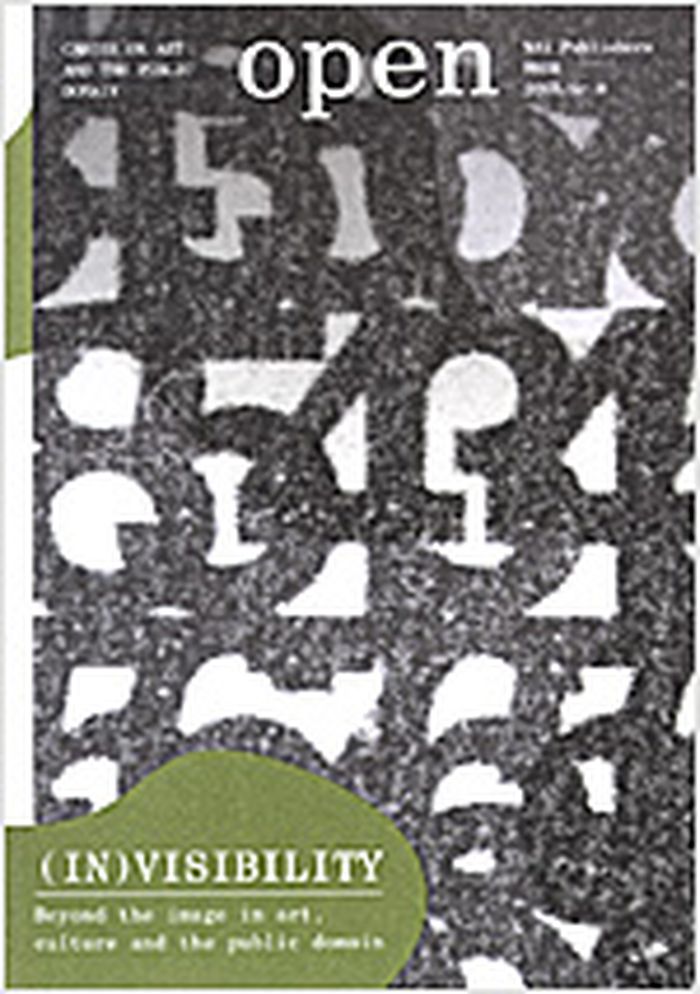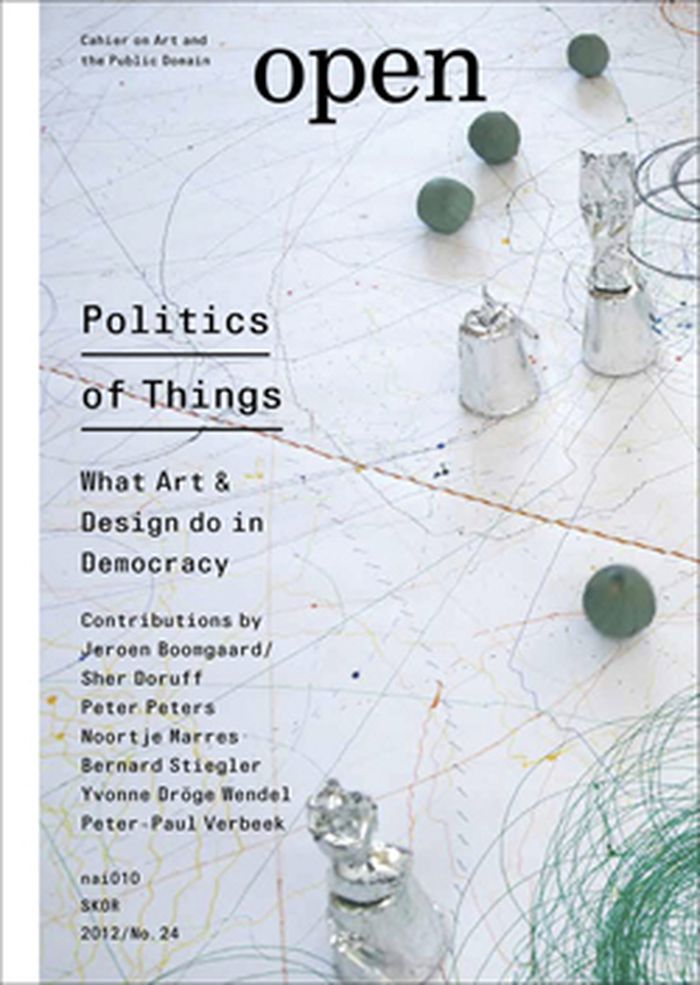$36.00
(available to order)
Summary:
In our culture, in which the media play a predominant role, there is an increasing emphasis on achieving visibility and transparency. Openness and communication are subservient to that visibility, and even seem to coincide with it more and more emphatically. At the same time, both notions form the foundations for social order and political power. In our over-visualized(...)
Open 8 : (in)visibility : beyond the image in art, culture and the public domain
Actions:
Price:
$36.00
(available to order)
Summary:
In our culture, in which the media play a predominant role, there is an increasing emphasis on achieving visibility and transparency. Openness and communication are subservient to that visibility, and even seem to coincide with it more and more emphatically. At the same time, both notions form the foundations for social order and political power. In our over-visualized culture, however, it seems as if every message or social agenda is being squeezed out in favour of styling, commerce and fashion. What position does art occupy in this, or what position should it occupy? In "Open" 8, guest editors Willem van Weelden and Jan van Grunsven write a general introduction, Brian Holmes explores (in)visibility as a tactic in art, and Jouke Kleerebezem asks who actually decides about (in)visibility in the public space; Camiel van Winkel writes over the visual deficit of contemporary culture; Dieter Lesage critically examines the proposals by OMA/AMO for a new iconography of Europe; Henk Oosterling investigates the FBI's prosecution of the Critical Art Ensemble; Jorinde Seijdel considers how media images are used as evidence for social and political events. "Open" 8 includes interviews with Arno van der Mark of DRFTWD, an Amsterdam-based multidisciplinary design bureau, and with the French research organization Bureau d'études, as well as an account of a roundtable discussion about a possible new legitimation for academic training in 'art and the public space'. The cahier also presents a column by the Belgian architect/author Wouter Davidts, photographic essays and book reviews.
Magazines
journals and magazines
Open 6 (in)security
$36.00
(available to order)
Summary:
There is a yearning for security in today's public domain. The individual and the community are increasingly demanding protection from and control over the space, themselves and others. A society of control is looming, but one lacking a clear idea about the nature and the origin of its underlying fears. This cahier examines the consequences of the current preoccupation(...)
Magazines
August 2004, Rotterdam
Open 6 (in)security
Actions:
Price:
$36.00
(available to order)
Summary:
There is a yearning for security in today's public domain. The individual and the community are increasingly demanding protection from and control over the space, themselves and others. A society of control is looming, but one lacking a clear idea about the nature and the origin of its underlying fears. This cahier examines the consequences of the current preoccupation with security for the public space and the visual arts. What are the implications for the functioning of the public domain, for its arrangement, design and experience? And how does this influence the task and perception of art? From art, architecture, philosophy and politics come theoretical and practical scenarios, proposals and visions that expose something of today's security paradigm, advocate alternative (conceptual) models or offer insights into the current ethics and aesthetics of security. Gijs van Oenen subjects the 'new securityscape' to a critical analysis. Lieven De Cauter digs into the various strata of the new fear. Sean Snyder presents images from his Temporary Occupation project. Thomas Y. Levin looks at how artists deal with surveillance in the public space. Sven Lütticken reflects on the concept of a 'human park' in philosophy, art and media. Harm Tilman focuses on architecture in a society of control. Mark Wigley analyses the issue of security in relation to the World Trade Center buildings in New York. Hans Boutellier wishes art would apply the brakes to the security Utopia. Jouke Kleerebezem calls for vigilance in the information society. Willem van Weelden discusses the project in Kanaleneiland, Utrecht. Q.S. Serafijn shows multiple dimensions of the interactive D-Tower in Doetinchem. Mark Wigley dissects the abode of the Unabomber.
journals and magazines
August 2004, Rotterdam
Magazines
$36.00
(available to order)
Summary:
The modern design and perception of the public domain is to a large degree determined by the tension between different memories - individual and collective, old and new, indigenous and immigrant. This makes memory a topical theme in the public domain, and its content, management and place are in urgent need of renewed consideration. How can one actively make use of the(...)
Open 7 (no)memory : storing and recalling in contemporary art and culture
Actions:
Price:
$36.00
(available to order)
Summary:
The modern design and perception of the public domain is to a large degree determined by the tension between different memories - individual and collective, old and new, indigenous and immigrant. This makes memory a topical theme in the public domain, and its content, management and place are in urgent need of renewed consideration. How can one actively make use of the information that is stored in modern-day 'places of memory'? What role does art play in this? Is collective memory even a possibility these days? How can cultural heritage be made accessible without transforming city and countryside into one big open-air museum? And what are the implications of new media and digital storage technologies for the social and historical processes of preserving and remembering? Rudi Laermans analyses the modern-day 'heritage regime'. Frank van Vree examines the role of the contemporary monument. Cor Wagenaar advocates the introduction of time as an instrument for the Belvedere Policy. Wolfgang Ernst considers how the archive becomes a literal metaphor in a digital culture. Nico Bick photographed various archives. Jorinde Seijdel takes a closer look at the visual archive of Bill Gates. Sven Lütticken writes about the conspiracy of openness that is apparently at work in the mass media. Geert Lovink interviews artist and archivist Tjebbe van Tijen. Artists' contributions from Joke Robaard, Nico Dockx, Hans Aarsman, Arnoud Holleman and Barbara Visser. Other contributions by Henk Oosterling, Brigitte van der Sande, Stef Scagliola, Jordan Crandall and Paul Meurs.
Magazines
$36.00
(available to order)
Summary:
Sound is everywhere and plays a crucial role in the experience and perception of public space. Nevertheless, in the reflection about that space and its organization, the visual image usually takes centre stage. Over recent years, however, there seems to have been a sensitization to the auditory aspects of daily life and the public domain. In the visual arts in particular,(...)
Open 9 Sound : sound in art and culture
Actions:
Price:
$36.00
(available to order)
Summary:
Sound is everywhere and plays a crucial role in the experience and perception of public space. Nevertheless, in the reflection about that space and its organization, the visual image usually takes centre stage. Over recent years, however, there seems to have been a sensitization to the auditory aspects of daily life and the public domain. In the visual arts in particular, but also in architecture and landscape architecture, people are studying the potential of sound as an element that can lend meaning in relation to social or spatial surroundings. The medium of radio seems to be undergoing a cultural revival, and research into image-sound relationships has become an important subject within the field of 'cultural studies'. What is the role of sound and the sense of hearing in the public domain? An investigation of the topicality and the effects of sound, from the perspectives of cultural philosophy, art theory and media theory, could provide fresh insights into the current conditions of the public domain. With contributions by Jonathan Sterne, Dirk van Weelden, Edwin Carels, Moniek Toebosch, Suzanne van de Ven, Studio Popcorn, RadioDays and many others.
Magazines
Open 13 2007
$46.00
(available to order)
Summary:
With the rise of less formal, more personal media outlets like YouTube and blogs, the mass media is no longer our only public forum. This issue of the Dutch architectural journal Open investigates these new user-tailored media, asking, "What are the opportunities for artistic practices and critical forms of publicness"�
Open 13 2007
Actions:
Price:
$46.00
(available to order)
Summary:
With the rise of less formal, more personal media outlets like YouTube and blogs, the mass media is no longer our only public forum. This issue of the Dutch architectural journal Open investigates these new user-tailored media, asking, "What are the opportunities for artistic practices and critical forms of publicness"�
sale books
$33.00
(available to order)
Summary:
Power to the imagination! is a renowned rallying cry of the May 1968 uprisings in Paris. But today, many of those who invoke a populist political imagination now—Berlusconi, the Tea Party, the Dutch right-wing populist Geert Wilders and others—have intentions of a quite different nature. This edition of Open addresses imagination and myth in the political arena.
Magazines
February 2011
Open 20: The populist imagination
Actions:
Price:
$33.00
(available to order)
Summary:
Power to the imagination! is a renowned rallying cry of the May 1968 uprisings in Paris. But today, many of those who invoke a populist political imagination now—Berlusconi, the Tea Party, the Dutch right-wing populist Geert Wilders and others—have intentions of a quite different nature. This edition of Open addresses imagination and myth in the political arena.
Magazines
Open19: Beyond privacy
$48.00
(available to order)
Summary:
New technologies are rapidly redefining our notions of privacy. Beyond Privacy examines the current trends of both increased governmental collection of personal data and the volunteering of information in the media and on the internet. The book considers the need for new philosophical and practical parameters to understand personal protection and autonomy.
Open19: Beyond privacy
Actions:
Price:
$48.00
(available to order)
Summary:
New technologies are rapidly redefining our notions of privacy. Beyond Privacy examines the current trends of both increased governmental collection of personal data and the volunteering of information in the media and on the internet. The book considers the need for new philosophical and practical parameters to understand personal protection and autonomy.
Magazines
Open 24 : politics of things
$30.00
(available to order)
Summary:
In 2005, Bruno Latour and Peter Weibel produced Making Things Public: Atmospheres of Democracy, an exhibition and publication about the role of art and design in democratic processes. Open 24 looks at their representation in the public domain.
Magazines
February 2013
Open 24 : politics of things
Actions:
Price:
$30.00
(available to order)
Summary:
In 2005, Bruno Latour and Peter Weibel produced Making Things Public: Atmospheres of Democracy, an exhibition and publication about the role of art and design in democratic processes. Open 24 looks at their representation in the public domain.
Magazines






